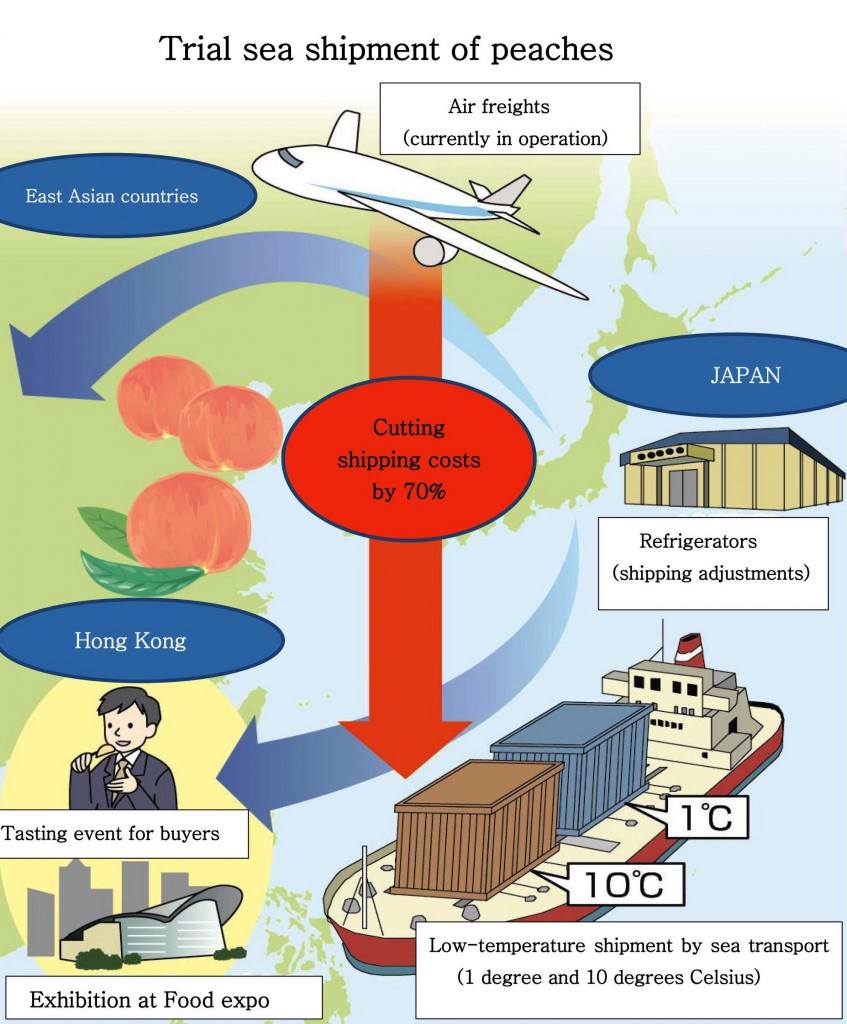In an effort to double exports of premium peaches to East Asian countries, Okayama University’s research team will set on a trial shipment to establish a low-cost marine transportation system for peaches.
Currently, exports of peaches are limited to air freights, as peaches ripen and deteriorate quickly at room temperature but are also vulnerable to low temperature. The research team will start shipping peaches on Sunday, July 13, from Okayama Prefecture to experiment its technology of extending the storage life of peaches to roughly two weeks.
 The experiment will be conducted for two years, using the Ministry of Agriculture, Forestry and Fisheries’ subsidies offered to projects to develop innovative technology to strengthen agriculture. The team will start shipping peaches this month so that they will be ready for sale as gifts during the summer holiday season in East Asian countries, including the Ghost Festival in mid-August and the Mid-Autumn Festival in mid-September.
The experiment will be conducted for two years, using the Ministry of Agriculture, Forestry and Fisheries’ subsidies offered to projects to develop innovative technology to strengthen agriculture. The team will start shipping peaches this month so that they will be ready for sale as gifts during the summer holiday season in East Asian countries, including the Ghost Festival in mid-August and the Mid-Autumn Festival in mid-September.
According to Associate Prof. Ryohei Nakano of Okayama University’s Department of Agriculture, peaches become good for eating three days after harvest and become overripe in six days. They have been regarded as too sensitive and unfit for long-term storage or long-distance shipments, as they tend to suffer chilling injuries if they are kept under refrigeration to extend their storage life. Since peach exports are currently limited to transport by air, the amount of peach exports range between 400 tons and 500 tons a year, accounting for only 0.3 percent of total domestic production.
Nakano’s team has found out that white peach varieties harvested from late July to early August start to darken when stored at a temperature of 5 degrees Celsius. When they are stored at 10 degrees, however, chilling injuries do not occur and they become good for eating in two weeks. They also found out that when the peaches are kept in a zero-degree environment for two weeks and then moved to a 25-degree environment for ripening, they become good for eating in two or three days.
Based on such data, the team will put peaches in two types of containers – one whose temperature is kept at 1 degree and the other at 10 degrees – and compare the fruit quality after sending them by ship. They will also store peaches in a zero-degree environment and see to what extent they can control the timing of shipment. In order to prevent the packaged fruits from shriveling, they are developing cardboard boxes which can maintain adequate humidity.
The team plans to start the trial by shipping packed Hakuho brand peaches from a port in Fukuoka Prefecture bound for Hong Kong, which will take 8 days. The team is expected to conduct full-scale trial shipments with Okayama Yume Hakuto peaches in early August and with late season breeds in September. Team members will hold tasting events for buyers in Hong Kong and participate in a food expo which will be held there between August 14 and 18 to see how the fruits are received by local people.
“By shifting from air freights to sea transport, it is possible to cut shipping costs by 70 percent,” Nakano says, adding that the team hopes to double peach exports in five years by creating a stable marine transportation system.
The trial shipments will be conducted by a consortium of Okayama University, Osaka-based packaging firm Rengo Inc.’s research institute and Okayama-based industrial and agricultural material manufacturer Nisshoku Group Inc. which owns low-temperature warehouses. The project will be supported by JA Zen-Noh Okayama which markets agricultural products and City Super Japan Ltd., a Japanese subsidiary of a Hong Kong-based major supermarket chain.
(July 8, 2014)

